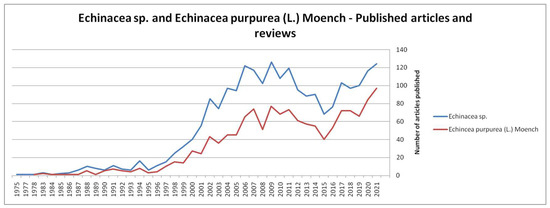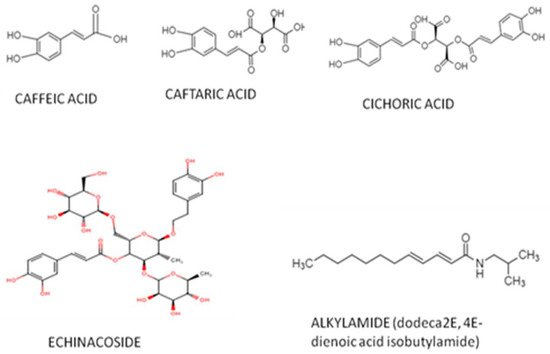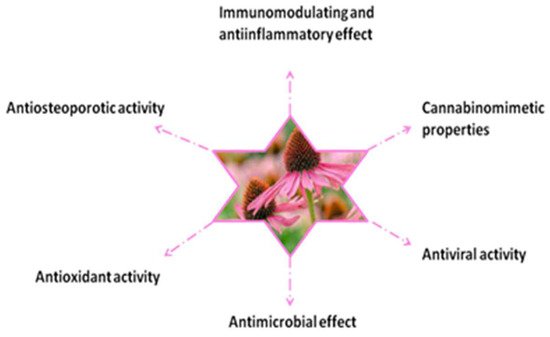Nature has always been a great source of therapeutic substances, providing us with various medicinal plants that produce valuable phytochemicals.
This evaluation's primary goal is the synthesis of the data from the specialized literature regarding the bioactive compounds, chemical composition, pharmacological and biological properties of Echinacea purpurea (L.) Moench to highlight the possibilities and perspectives for future studies, and to obtain safe and pharmacologically effective products.
2. Bioactive Compounds of Echinacea purpurea (L.) Moench
Several significant groups of bioactive compounds, with pharmacological activities, have been isolated from Echinacea species. The most important components of
Echinacea purpurea (L.) Moench are alkylamides, polysaccharides, glycoproteins, flavonoids and phenolic compounds, which include [
22] derivates of caffeic acid, like caffeic acid, chicoric acid, caftaric acid, chlorogenic acid and echinacoside,
Figure 2, [
23,
24], whose amounts vary based on the plant's sections. In addition to these components, we also identified thatphylloxanthobilins, β-phellandrene, acetaldehyde, dimethyl sulfide, camphene, hexanal, α-pinene and limonene are present in all plant tissues, regardless of species. Fatty acids, aldehydes and terpenoidsare constituents whose presence depend on the parts of plants used [
25,
26,
27,
28,
29,
30,
31,
32,
33,
34,
35,
36,
37,
38].
Figure 2. Structure of major compounds.
The chemical components responsible for the immunomodulatory activities of purple coneflower roots are glycoproteins, alkylamides and polysaccharides [
39]. Glycoproteins are proteins and carbohydrate chains that have a role in a variety of physiological activities, including immunology. Alkylamides are a kind of chemical found in genus Echinacea (Asteraceae) that has been demonstrated to have high bioavailability and alsoimmunomodulatory properties. Structurally, they have a common feature of an amine bond and usually contained an aliphatic chain of polyunsaturated fatty acids connected to a short-chain amine. Polysaccharides are complex carbohydrate polymers made up of more than two monosaccharides. The Asteraceae family contains important polysaccharides, pectins, arabinogalactans and inulin. Bioactive polysaccharides may substantiate a part of the traditional uses of these species.
EP supplements are, in general, sold as encapsulated tablets containing aerial parts or dried roots or as tablets containing extruded material from pressed plants or ethanol extracts.
The above-ground parts of the plant contain smaller amounts of volatile oils and pyrolizid alkaloids such as tussilagin and isotussilagin than the root [
40].
The most important derivative of caffeic acidof the
Echinacea purpurea (L.) Moench species is considered to be chicoric acid, the most predominant phenolic component in the root and petiole [
41,
42,
43,
44,
45]. Chicoric acid is the most abundant phenolic component in the root and petiole of
Echinacea purpurea (L.) Moench. These antioxidant and antibacterial compounds can help the immunological system of the body to function better. However, caffeic acid derivative concentrations will vary according to EP species, organ type, growing conditions and environmental factors.
Using the HPLC method, some studies demonstrated the retention of caffeic acid derivatives in dried EP. It was reported that chicoric acid accounted for 63% and 67%, respectively, of the relative peak area for aerial sections. By using the HPLC method, caffeic acid cannot be detected in all dried flowers. In contrast, the caffeic acid content was 8–18% of the measured relative peak area [
46,
47,
48]. Chicoric acid (71.45%) is the most predominant caffeic acid derivative in flowers, followed by caffeic acid (23.25%) [
49].
Echinacoside was discovered to have a variety of pharmacologically important benefits on human health, particularly neuroprotective and cardiovascular effects [
35,
50]. Echinacosite is a caffeic acid derivative found in the flower at a concentration of 1.45% [
48]. In addition to these substances, Echinacea species contain flavonoids, polyacetylenes and alkaloids [
51,
52].
The constituents that are also important, isolated from the extracts of
Echinacea purpurea (L.) Moench leaves, are phylloxanthobilins. The breakdown of chlorophyll produces these natural tetrapyrrole compounds. Phylloxanthobilins were identified in the leaves of deciduous trees about 10years ago and are currently considered a compound class with great bioactivity potential, which has yet to be studied. However, there have been no reports of phylloxanthobines being found in sections of a medicinal plant utilized in pharmaceutical formulations until now [
53,
54].
β-phellandrene was discovered to be prominent in the roots of EP, but lacking in all tissues of
Echinacea pallida Nutt, in one research study using gas chromatography/mass spectrometry. α-Myrcene was found in large concentrations in all three Echinacea species' flowers, leaves and stems, but was missing from the roots of
Echinaceae angustifolia and
Echinacea purpurea (L.) Moench and was only in small concentrations in the roots of
Echinacea pallida Nutt. Acetaldehyde, dimethyl sulfide, camphene, hexanal, α-pinene and all plant tissues contain limonene, regardless of species. Dimethyl sulfide has been identified in trace amounts in all species' leaves, stems and flowers; nonetheless, it was the most abundant ingredient in
Echinacea pallida roots and, second, was the most abundant component in
Echinacea angustifolia and
Echinacea purpurea (L.) Moench roots. Butanals and propanals, in particular, are aldehydes, comprising 41–57% of root tissue headspace and 19–29% of leaf tissue headspace, and just 6–14% of the headspace between the bloom and the stem tissue. Terpenoids such as α–myrcene, β– and α–pinene, ocimene, camphene, terpenene and limonene constitute between 82–91% of the headspace of stems and flowers, 46–58% of the leaf tissue's headspace and 6–21% of the roots. Furthermore, there are 14 hydrocarbons, 12 alcohols, 7 esters, 6 ketones and 7 other chemicals found [
55,
56,
57]. In another study, we identified compounds in an n-hexane extract of
Echinacea purpurea (L.) Moench such as fatty acids comprising 9,12-octadecadienoic acid (linoleic acid), hexadecanoic acid (palmitic acid) and octadecanoic acid (stearic acid), accounting for 25.8% of the extract, and after that come the next long-chain hydrocarbons (14.6%) and sterols (13.9%) [
58].
EP has also been prepared for use as a topical treatment for skin and wound inflammation. In addition, Echinacea products are licensed in Europe to heal infections of the upper respiratory tract and wound healing [
59,
60,
61,
62].
Many bioactivities of EP have been discovered in modern pharmacological investigations, including immunomodulatory, anti-inflammatory, antioxidant, antiviral and antifungal activities [
63,
64].
Chronic arthritis, cancer, antimicrobial action, persistent fatigue syndrome, HIV infection, a range of skin ailments, wounds and chronic pelvic infections were all mentioned as potential therapeutic uses for EP [
65].
Preparations containing EP are among the best-selling herbal medications in Europe and the United States [
60,
66]. EP supplementation may decrease the severity and duration of acute respiratory tract infections, according to current research; however, no studies have been identified using Echinacea to prevent or treat the SARS-CoV virus infection [
67].
The immunomodulatory effects of Echinacea species are of primary concern for research, especially those related to upper respiratory tract infections. Discoveries made recently have also shown that certain standardized preparations of Echinacea have strong antiviral, antifungal, antimicrobial, anti-inflammatory, antioxidant and psychoactive activities. Given the available data, preparations obtained from Echinacea are well-tolerated by the human organism [
68]. Therefore, further investigations are needed to ensure the quality and safety of the various preparations of Echinacea sp. [
69]. Echinacea sp. can cause minor side effects; it should be considered if the patient who is receiving Echinacea sp. preparations is allergic to
Ambrosia artemisifolia L. or other species of the Asteraceae family.
Echinacea sp., like many other Asteraceae plants, includes phototoxic polyacetylene compounds that can be inactivated with minimal processing [
70,
71].
It is important to note that during preservation, enzymatic processes have the potential to degrade bioactive substances as a result of long-term storage from collection to marketing, leading in compositional changes.
Stuart and Wills (2000) studied the alkylamide and chicoric acid content of ground and dried
Echinacea purpurea (L.) Moench roots for 60 days,
Table 1 [
71,
72].
Table 1. Correlation between the storage condition and bioactive compounds concentration.
3. Biological and Pharmacological Effects of Echinacea purpurea (L.) Moench
Currently, the number of herbs that are subject to scientific studies is increasing. The well-known medicinal plants are intensively studied to obtain the most accurate data about the chemical composition, the pharmacological effects and the safety of use in therapy [
73].
Table 2 summarizes the most important components identified in Echinacea purpurea (L.) Moench and the scientifically proven biological and pharmacological effects, according to the literature. It can be seen that most of the demonstrated effects are common to several compounds, such as the immunomodulatory, antioxidant or antimicrobial effects.
Table 2. Biological and pharmacological effects of the bioactive compounds of Echinacea purpurea (L.) Moench.
Following the study of the literature, we identified a large number of scientifically proven therapeutic properties for Echinacea purpurea (L.) Moench (Figure 3).
Figure 3. Properties of Echinacea purpurea (L.) Moench.



